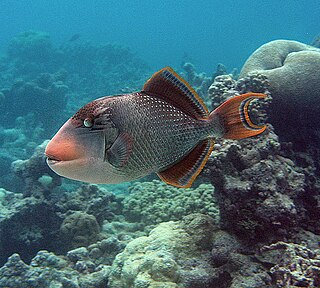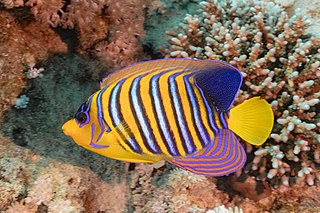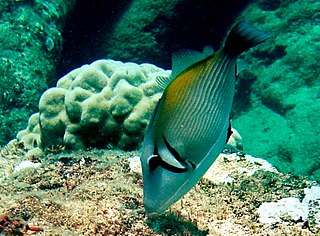
Triggerfish are about 40 species of often brightly colored fish of the family Balistidae. Often marked by lines and spots, they inhabit tropical and subtropical oceans throughout the world, with the greatest species richness in the Indo-Pacific. Most are found in relatively shallow, coastal habitats, especially at coral reefs, but a few, such as the oceanic triggerfish, are pelagic. While several species from this family are popular in the marine aquarium trade, they are often notoriously ill-tempered.

The clown triggerfish, also known as the bigspotted triggerfish, is a demersal marine fish belonging to the family Balistidae, or commonly called triggerfish.

The yellowmargin triggerfish, pineapple trigger, yellowface triggerfish or yellow-face triggerfish is a marine fish in the family Balistidae. It is found in coastal tropical waters and reefs of the Indo-Pacific from the Red Sea south to Natal, South Africa and east from southern Japan south to Indonesia, Philippines and Samoa, at water depths from 2–50 m (6.6–164.0 ft).

The lagoon triggerfish, also known as the blackbar triggerfish, the Picasso triggerfish, or the Picassofish, is a triggerfish, up to 30 cm in length, found on reefs in the Indo-Pacific region.

The titan triggerfish, giant triggerfish or moustache triggerfish is a large species of triggerfish found in lagoons and at reefs to depths of 50 m (160 ft) in most of the Indo-Pacific, though it is absent from Hawaii. With a length of up to 75 centimetres (30 in), it is the largest species of triggerfish in its range.

Demersal fish, also known as groundfish, live and feed on or near the bottom of seas or lakes. They occupy the sea floors and lake beds, which usually consist of mud, sand, gravel or rocks. In coastal waters they are found on or near the continental shelf, and in deep waters they are found on or near the continental slope or along the continental rise. They are not generally found in the deepest waters, such as abyssal depths or on the abyssal plain, but they can be found around seamounts and islands. The word demersal comes from the Latin demergere, which means to sink.

The orange-lined triggerfish is a demersal triggerfish. Although Balistapus is a monotypic genus, it is closely related to the genus Balistoides.

The halfmoon triggerfish, Sufflamen chrysopterum, is a triggerfish of the tropical Indo-West Pacific area.

The pennant coralfish, also known as the longfin bannerfish, reef bannerfish or coachman, is a species of fish of the family Chaetodontidae, native to the Indo-Pacific area.

The royal angelfish, or regal angelfish, is a species of marine ray-finned fish, a marine angelfish belonging to the family Pomacanthidae, and the monotypic genus Pygoplites. It is found in tropical Indo-Pacific oceans. It can grow as long as 25 cm.
Although most species in the Red Sea pose no threat to humans, there are a few notable exceptions.

Cantherhines dumerilii is a species of fish in the family Monacanthidae, the filefishes. Its common names include whitespotted filefish, barred filefish, orange-fin file, and yelloweye leatherjacket. It is distributed in the Indian and Pacific Oceans where it is found on coral reefs.

The blackbelly triggerfish is a ray-finned fish in the family Balistidae found in the Indo-Pacific. It occasionally makes its way into the aquarium trade. It is sometimes known as the blackpatch triggerfish.

Xanthichthys ringens, the Sargassum triggerfish, is a species of triggerfish from the Western Atlantic, ranging from North Carolina (USA) to Brazil.

Sufflamen bursa the Lei Triggerfish is also known as the bursa triggerfish, scythe triggerfish or boomerang triggerfish, is a triggerfish from the Indo-Pacific. Its name is derived from the two markings behind its eyes that wrap around the fish similar to a Hawaiian Lei. The color of these markings changes depending on the fish's mood, in which case the colors may alter from yellow, dark brown, and black. It is a species of reef fish found in reef ecosystems in the Indo-Pacific, including Japan, Australia, and Hawaii. It occasionally makes its way into the aquarium trade.

Fish are very diverse animals and can be categorised in many ways. This article is an overview of some of ways in which fish are categorised. Although most fish species have probably been discovered and described, about 250 new ones are still discovered every year. According to FishBase about 34,800 species of fish had been described as of February 2022, which is more than the combined total of all other vertebrate species: mammals, amphibians, reptiles and birds.

Coral reef fish are fish which live amongst or in close relation to coral reefs. Coral reefs form complex ecosystems with tremendous biodiversity. Among the myriad inhabitants, the fish stand out as colourful and interesting to watch. Hundreds of species can exist in a small area of a healthy reef, many of them hidden or well camouflaged. Reef fish have developed many ingenious specialisations adapted to survival on the reefs.

Coastal fish, also called inshore fish or neritic fish, inhabit the sea between the shoreline and the edge of the continental shelf. Since the continental shelf is usually less than 200 metres (660 ft) deep, it follows that pelagic coastal fish are generally epipelagic fish, inhabiting the sunlit epipelagic zone. Coastal fish can be contrasted with oceanic fish or offshore fish, which inhabit the deep seas beyond the continental shelves.

Poisonous fish are fish that are poisonous to eat. They contain toxins which are not destroyed by the digestive systems of animals that eat the fish. Venomous fish also contain toxins, but do not necessarily cause poisoning if they are eaten, since the digestive system often destroys their venom.


















